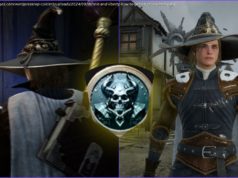Baldur’s Gate 3 is an overwhelming, D&D-fueled experience. Our beginner’s guide will show you the ropes of D&D and offer some tips on getting started in BG3.
Baldur’s Gate 3 is out of early access, and it’s time to head to Faerun. Whether this is your first experience with a Baldur’s Gate game or you’re a returning player, our beginner’s guide will help you get started.
In this Baldur’s Gate 3 guide, we’ll give you a crash course in the rules of Dungeons & Dragons, talk a little about the quirks of combat, and give some guidance about how to approach conversations, how often to save (a lot), and when to reload your game if you screw up.Don’t stress too much about choosing your class
Right out of the gate, Baldur’s Gate 3 asks you to make a bunch of decisions about your character — like your appearance, race, and class. It’s a bunch of big and lasting decisions all at once. We’ve got a guide to help you choose your class, but — more importantly — the class you choose isn’t permanent. There’s an NPC you’ll meet who can help you undo any mistakes you might’ve made while creating your character.The underlying rules are Dungeons & Dragons 5th edition
Baldur’s Gate has always been based on D&D, and Baldur’s Gate 3 adheres to the most recent edition of the wildly popular tabletop role-playing game. That means a couple things. If you’re familiar with 5th edition, you already understand almost everything that’s going on. If you’re not, though, it makes the game even more intimidating. However…You don’t need to know D&D to play Baldur’s Gate
When it comes to mechanics, Baldur’s Gate 3 does all the work for you — it’s a video game, after all. The game and its engine serve as character sheet, dice roller, and Dungeon Master. All you have to do is click on things.
It’s (obviously) not quite as simple as that, but don’t be intimidated. There are things you’ll need to know, but most of them are ubiquitous video game rules at this point. Let’s talk about the basics first.A brief D&D crash course
In D&D — and by extension, Baldur’s Gate 3 — your character interacts with the world based on their stats — Abilities and Skills — and dice rolls.Abilities and Skills
Your abilities are Strength (physical strength), Dexterity (agility and deftness), Constitution (willpower and heartiness), Intelligence (book smarts), Wisdom (intuition and street smarts), and Charisma (strength of personality). Abilities are on a 20-point scale, with 1 being the lowest, 10 being average, and 20 being superhuman.
Abilities inform your Skills. For example, if you have high strength, you’re automatically good at Athletics (like Jumping). If you have good Charisma, you’re good at Performance.Proficiency
Proficiency is a flat bonus that you add to things that your character is good at. If your character is a Gold Dwarf, for example, they’re Proficient with Warhammers, and you get a bonus when you use them.Skill Checks (and Attacks and Saving Throws, etc.)
When you try to do something in the game (both D&D and Baldur’s Gate 3), you roll a 20-sided die, add the appropriate Ability and Skill modifiers, add your Proficiency Bonus if you can, and then determine if you succeed.
This is happening all the time in Baldur’s Gate 3, both behind the scenes and overtly. You just don’t need to do any of the math.
For a more in-depth look at how your stats are figured out, read our Baldur’s Gate 3 character creation guide.Gameplay is a mix of real-time and turn-based
You’ll mostly interact with the world by clicking your mouse and having your character walk around. When you find something interesting — a chest or an enemy — you’ll click to interact with it.






